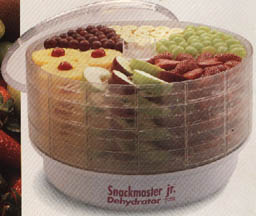
Garden Chat Notes
Topic: Dehydrating Food

To Our Garden Pathway
To Our Message Board
How to make Jerky
Vegetable Drying Chart.
Fruit Drying Chart.

This is a popular style dehydrator
Drying foods to preserve them is one of the oldest and also one of the easiest methods of preservation.
Drying requires only a limited amount of equipment. Most of the equipment needed for drying small quantities of food is commonly found in the kitchen.
Drying may be done outside in the sun, indoors in an oven, or in a dehydrator.
Sun Drying:
For sun drying, place tray or spead cloth on a rack or table high off the ground on a porch roof. Keeping the food off the ground helps protect it from dust, dirt, and animals. Cover fruit with a screen or thin clean cloth.
To make a simple outdoor dryier, use two large window screens, preferably with wooden frames. Place one screen on supports. Place cloth or trays containing food on screen. Cover with remaining screen. to prevent chance discoloration of food, keep screen from actual contact with the food.
Gloria brought up the subject of humidity.
Sun drying only works well in dryer climates where there is low humidity.
The idea is to dry the food as quickly as possible.
Oven Drying:
Turn temperature control to warm, 140 to 150 degrees F., warm setting on most normal ranges. Stack trays so air will circulate. Prop oven door slightly open to allow moisture to escape. (Door may be closed if oven has proper air ventilation.)
Avoid over-filling trays. As much fuel may be used when drying food on loaded trays as two drying with moderate loads.
Dehydrator:
All of this information was not covered in the chat, but I think since I have the information here, I will add it to make these notes more complete.
Pretreating Fruits:
Pretreating is not necessary for most fruits. However, some fruits tend to oxidize and trun brown more than others. Oxidation can also cause loss in flavor and vitamins A and C. To reduce oxidation, place fruit in a bath of Pineapple, orange, lemon or lime juice. You can also use ascorbic acid, but I have personally never used it.
Pretreating Vegetables:
Some vegetables need to be blanched. blanching softens the cell structure, allowing the moisture to escape more easily and also allows vegetables to rehydrate faster. You can blance vegetables by steming them until they are heated through, but not cooked. Vegetables should still be crunchy. Drain and place immediately on dryer trays.
Drying Time:
Drying times may vary, depending on the type and amount of food, thickness and eveness of the slices. Percentage of water in the food, humidity, temperature of the air and altitude. Drying times may also vary greatly from one area of the country to another and from day to day, depending on the climatic conditions. Record keeping helps you predict future drying times for specific foods.
Testing For Dryness:
Food must be carefully monitored near the end of the dehydration process to prevent overdrying. Overdried foods lose quality in texture, nutrition and taste. To test for dryness, remove a piece of food, allow it to cool, and feel with your fingers to determine dryness:
* Fruits should be pliable and leathery with no pockets of moisture. To check if fruit is dry, tear a piece in half and watch for moisture beads along the tear. If there aren't any, it is sufficiently dry for long term storage.
* Fruit roll-ups should be leathery with no sticky spots.
* Jerky should be tough but not brittle.
* Dried Fish should be tough. If the fish is high in fat, it may appear moist due to the high oil content.
*Vegetables should be tough or crisp.
On to discussion
To Our Message Board
To Our Garden Pathway
How to make Jerky
Vegetable Drying Chart.
Fruit Drying Chart.